Agile Methodologies: Scrum, Kanban, Tools & Implementation Review
VerifiedAdded on 2023/04/12
|24
|4465
|310
Report
AI Summary
This report provides a detailed comparison of Agile methodologies, focusing on Scrum and Kanban. It begins with an introduction to Agile Project Management (APM) and its iterative approach. The report describes Scrum, its roles (Scrum Master, Product Owner, Scrum Team), and practices, including the process flow and product backlog management. It then transitions to Kanban, explaining its origins, principles (visualization of work, limiting work in progress, focusing on flow, and continuous improvement), and its application in both technical and non-technical enterprises. The report also reviews other Agile methodologies such as eXtreme Programming (XP), Crystal, Dynamic Software Development Methodology (DSDM), Feature Driven Development (FDD), and Lean Software Development. Additionally, it explores software tools like Asana, TeamGantt, Paymo, Click-up, and Airtables, along with geographically diverse workgroup practices. The report concludes with a discussion on the reasons for choosing Agile methodology and provides recommendations for implementation, supported by APA references. This document is available on Desklib, a platform offering study tools for students.
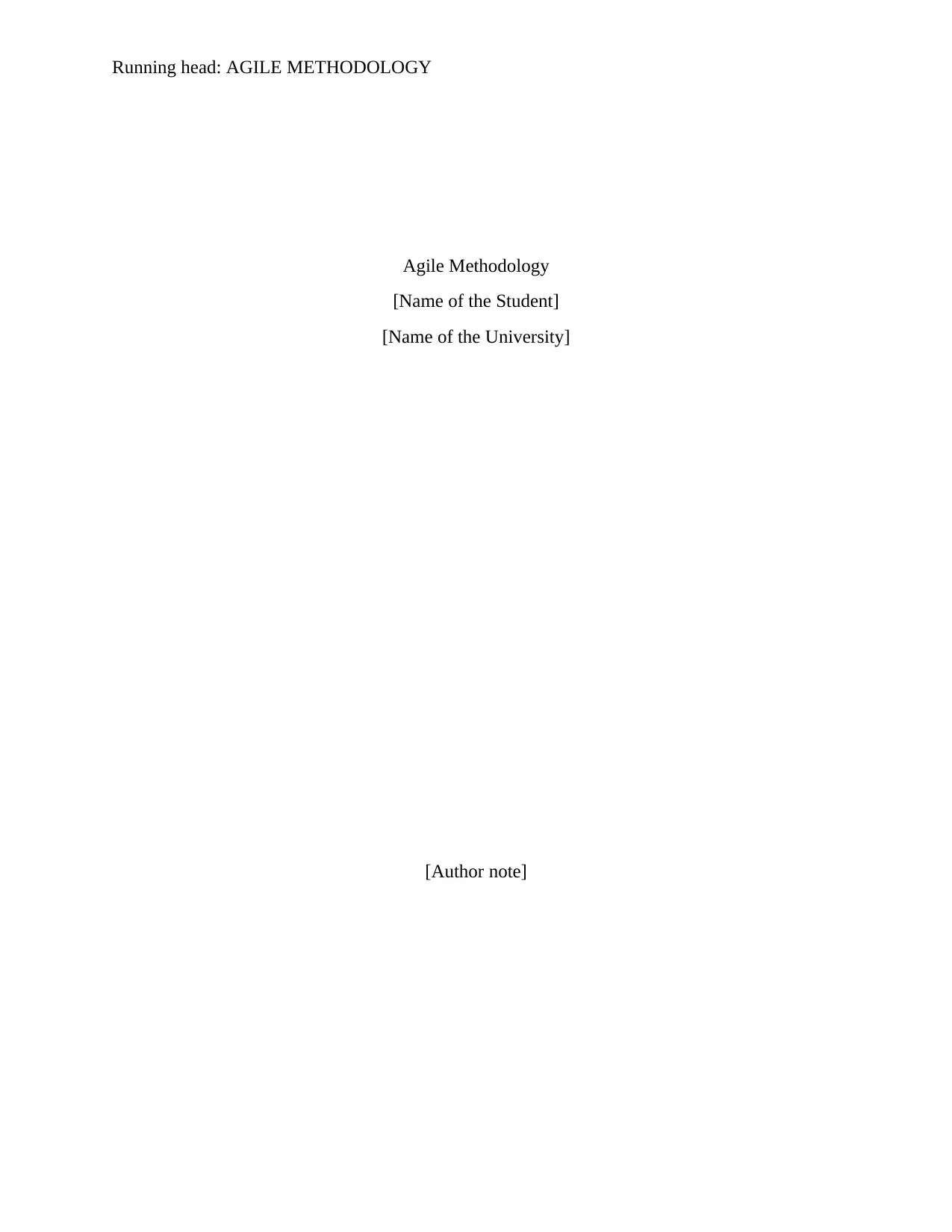
Running head: AGILE METHODOLOGY
Agile Methodology
[Name of the Student]
[Name of the University]
[Author note]
Agile Methodology
[Name of the Student]
[Name of the University]
[Author note]
Paraphrase This Document
Need a fresh take? Get an instant paraphrase of this document with our AI Paraphraser
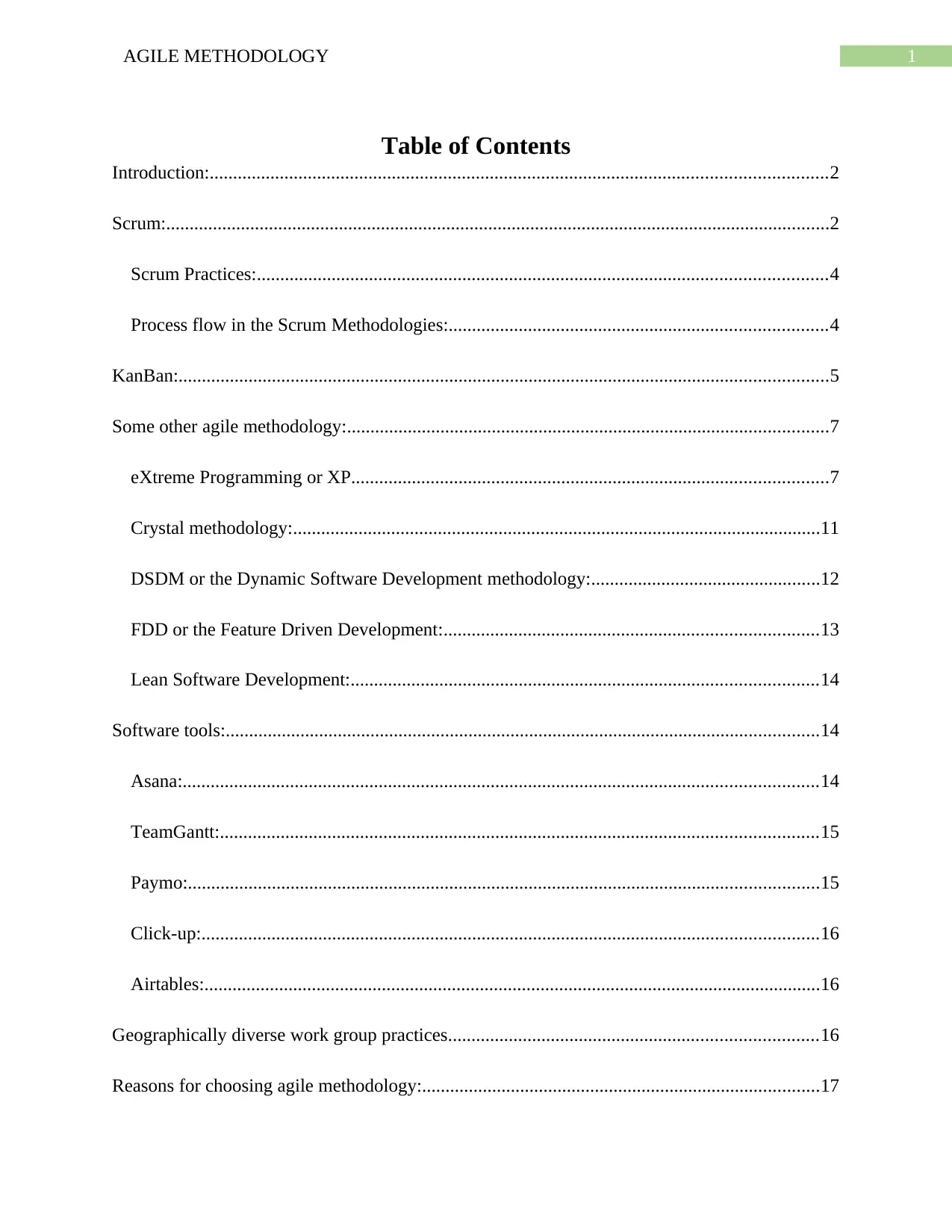
1AGILE METHODOLOGY
Table of Contents
Introduction:....................................................................................................................................2
Scrum:..............................................................................................................................................2
Scrum Practices:..........................................................................................................................4
Process flow in the Scrum Methodologies:.................................................................................4
KanBan:...........................................................................................................................................5
Some other agile methodology:.......................................................................................................7
eXtreme Programming or XP......................................................................................................7
Crystal methodology:.................................................................................................................11
DSDM or the Dynamic Software Development methodology:.................................................12
FDD or the Feature Driven Development:................................................................................13
Lean Software Development:....................................................................................................14
Software tools:...............................................................................................................................14
Asana:........................................................................................................................................14
TeamGantt:................................................................................................................................15
Paymo:.......................................................................................................................................15
Click-up:....................................................................................................................................16
Airtables:....................................................................................................................................16
Geographically diverse work group practices...............................................................................16
Reasons for choosing agile methodology:.....................................................................................17
Table of Contents
Introduction:....................................................................................................................................2
Scrum:..............................................................................................................................................2
Scrum Practices:..........................................................................................................................4
Process flow in the Scrum Methodologies:.................................................................................4
KanBan:...........................................................................................................................................5
Some other agile methodology:.......................................................................................................7
eXtreme Programming or XP......................................................................................................7
Crystal methodology:.................................................................................................................11
DSDM or the Dynamic Software Development methodology:.................................................12
FDD or the Feature Driven Development:................................................................................13
Lean Software Development:....................................................................................................14
Software tools:...............................................................................................................................14
Asana:........................................................................................................................................14
TeamGantt:................................................................................................................................15
Paymo:.......................................................................................................................................15
Click-up:....................................................................................................................................16
Airtables:....................................................................................................................................16
Geographically diverse work group practices...............................................................................16
Reasons for choosing agile methodology:.....................................................................................17

2AGILE METHODOLOGY
References:....................................................................................................................................19
References:....................................................................................................................................19
⊘ This is a preview!⊘
Do you want full access?
Subscribe today to unlock all pages.

Trusted by 1+ million students worldwide
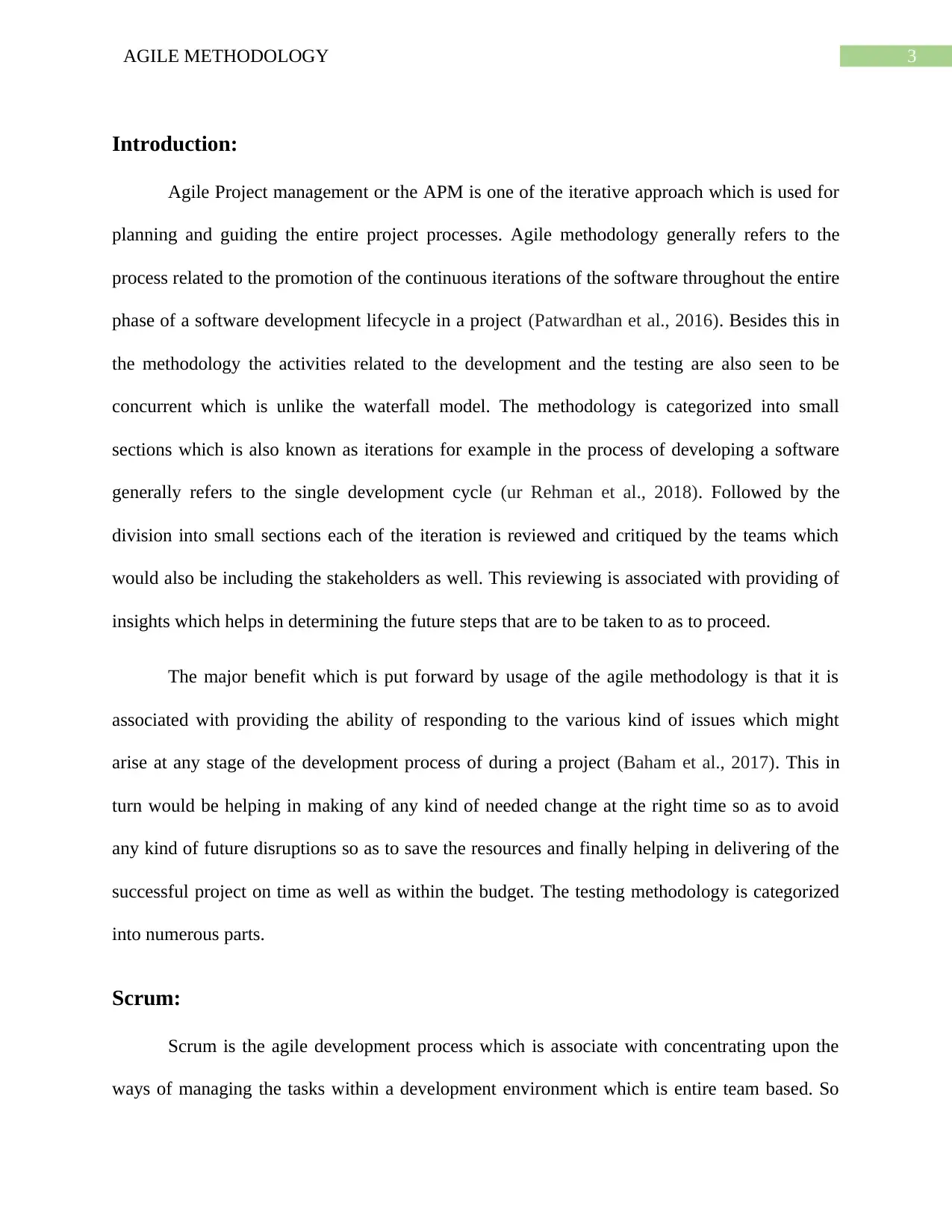
3AGILE METHODOLOGY
Introduction:
Agile Project management or the APM is one of the iterative approach which is used for
planning and guiding the entire project processes. Agile methodology generally refers to the
process related to the promotion of the continuous iterations of the software throughout the entire
phase of a software development lifecycle in a project (Patwardhan et al., 2016). Besides this in
the methodology the activities related to the development and the testing are also seen to be
concurrent which is unlike the waterfall model. The methodology is categorized into small
sections which is also known as iterations for example in the process of developing a software
generally refers to the single development cycle (ur Rehman et al., 2018). Followed by the
division into small sections each of the iteration is reviewed and critiqued by the teams which
would also be including the stakeholders as well. This reviewing is associated with providing of
insights which helps in determining the future steps that are to be taken to as to proceed.
The major benefit which is put forward by usage of the agile methodology is that it is
associated with providing the ability of responding to the various kind of issues which might
arise at any stage of the development process of during a project (Baham et al., 2017). This in
turn would be helping in making of any kind of needed change at the right time so as to avoid
any kind of future disruptions so as to save the resources and finally helping in delivering of the
successful project on time as well as within the budget. The testing methodology is categorized
into numerous parts.
Scrum:
Scrum is the agile development process which is associate with concentrating upon the
ways of managing the tasks within a development environment which is entire team based. So
Introduction:
Agile Project management or the APM is one of the iterative approach which is used for
planning and guiding the entire project processes. Agile methodology generally refers to the
process related to the promotion of the continuous iterations of the software throughout the entire
phase of a software development lifecycle in a project (Patwardhan et al., 2016). Besides this in
the methodology the activities related to the development and the testing are also seen to be
concurrent which is unlike the waterfall model. The methodology is categorized into small
sections which is also known as iterations for example in the process of developing a software
generally refers to the single development cycle (ur Rehman et al., 2018). Followed by the
division into small sections each of the iteration is reviewed and critiqued by the teams which
would also be including the stakeholders as well. This reviewing is associated with providing of
insights which helps in determining the future steps that are to be taken to as to proceed.
The major benefit which is put forward by usage of the agile methodology is that it is
associated with providing the ability of responding to the various kind of issues which might
arise at any stage of the development process of during a project (Baham et al., 2017). This in
turn would be helping in making of any kind of needed change at the right time so as to avoid
any kind of future disruptions so as to save the resources and finally helping in delivering of the
successful project on time as well as within the budget. The testing methodology is categorized
into numerous parts.
Scrum:
Scrum is the agile development process which is associate with concentrating upon the
ways of managing the tasks within a development environment which is entire team based. So
Paraphrase This Document
Need a fresh take? Get an instant paraphrase of this document with our AI Paraphraser
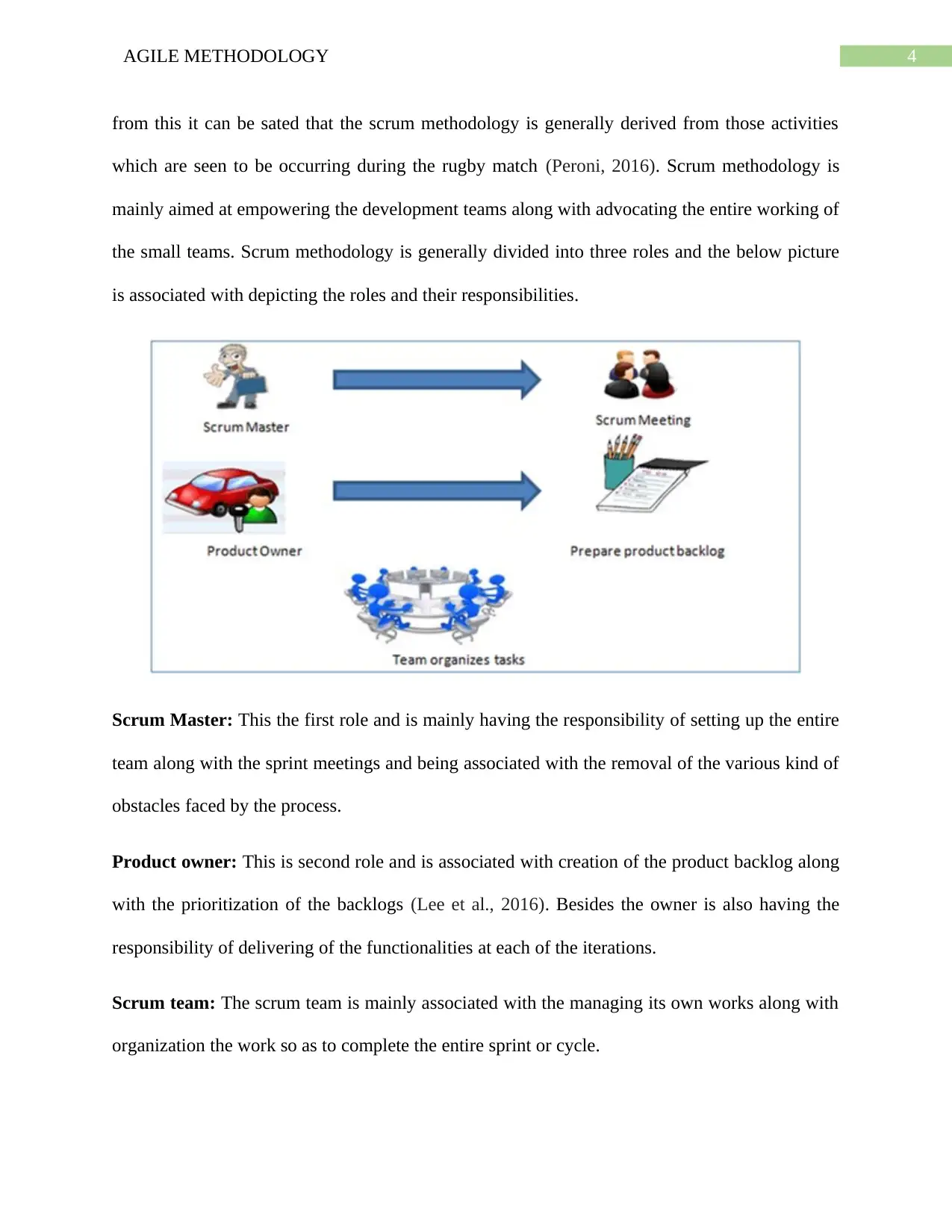
4AGILE METHODOLOGY
from this it can be sated that the scrum methodology is generally derived from those activities
which are seen to be occurring during the rugby match (Peroni, 2016). Scrum methodology is
mainly aimed at empowering the development teams along with advocating the entire working of
the small teams. Scrum methodology is generally divided into three roles and the below picture
is associated with depicting the roles and their responsibilities.
Scrum Master: This the first role and is mainly having the responsibility of setting up the entire
team along with the sprint meetings and being associated with the removal of the various kind of
obstacles faced by the process.
Product owner: This is second role and is associated with creation of the product backlog along
with the prioritization of the backlogs (Lee et al., 2016). Besides the owner is also having the
responsibility of delivering of the functionalities at each of the iterations.
Scrum team: The scrum team is mainly associated with the managing its own works along with
organization the work so as to complete the entire sprint or cycle.
from this it can be sated that the scrum methodology is generally derived from those activities
which are seen to be occurring during the rugby match (Peroni, 2016). Scrum methodology is
mainly aimed at empowering the development teams along with advocating the entire working of
the small teams. Scrum methodology is generally divided into three roles and the below picture
is associated with depicting the roles and their responsibilities.
Scrum Master: This the first role and is mainly having the responsibility of setting up the entire
team along with the sprint meetings and being associated with the removal of the various kind of
obstacles faced by the process.
Product owner: This is second role and is associated with creation of the product backlog along
with the prioritization of the backlogs (Lee et al., 2016). Besides the owner is also having the
responsibility of delivering of the functionalities at each of the iterations.
Scrum team: The scrum team is mainly associated with the managing its own works along with
organization the work so as to complete the entire sprint or cycle.
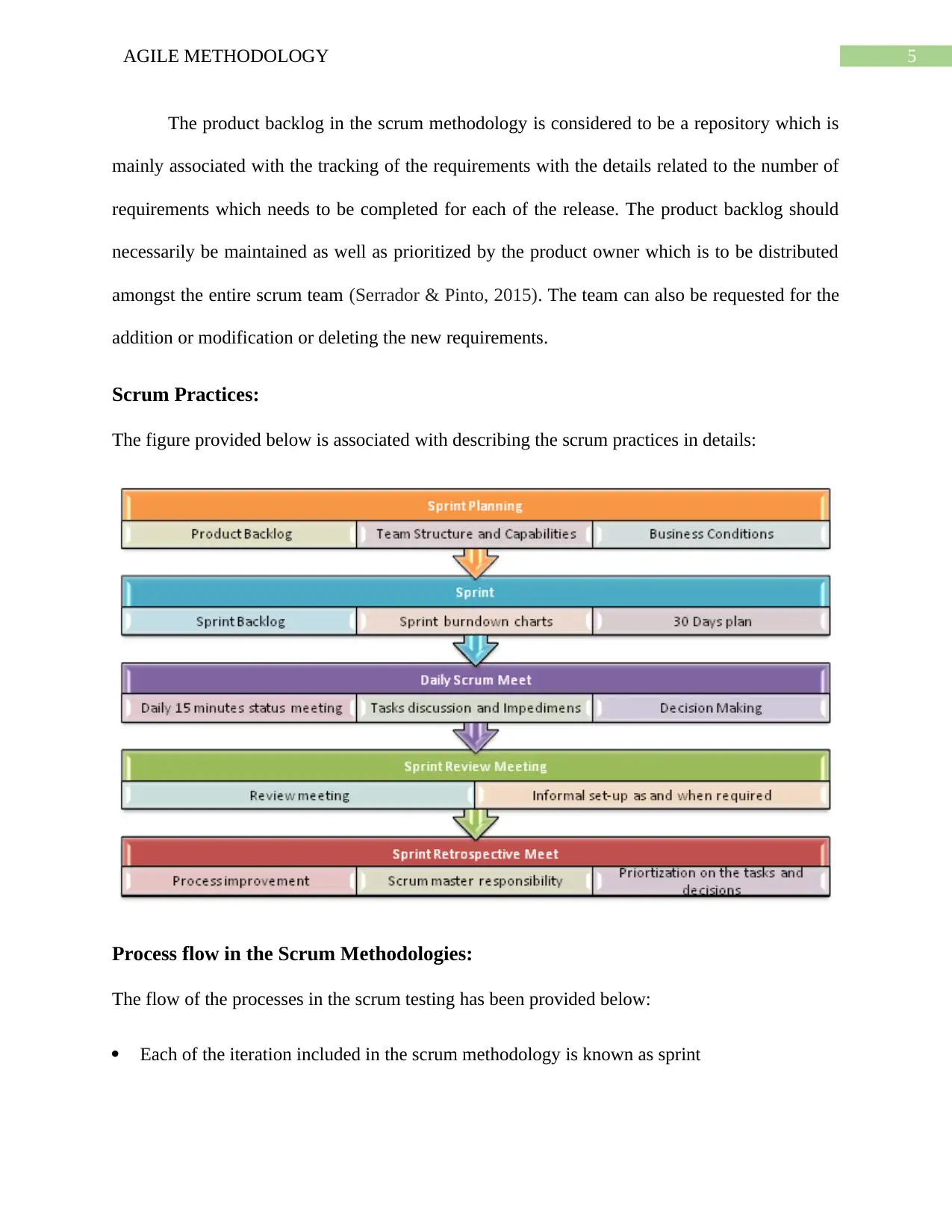
5AGILE METHODOLOGY
The product backlog in the scrum methodology is considered to be a repository which is
mainly associated with the tracking of the requirements with the details related to the number of
requirements which needs to be completed for each of the release. The product backlog should
necessarily be maintained as well as prioritized by the product owner which is to be distributed
amongst the entire scrum team (Serrador & Pinto, 2015). The team can also be requested for the
addition or modification or deleting the new requirements.
Scrum Practices:
The figure provided below is associated with describing the scrum practices in details:
Process flow in the Scrum Methodologies:
The flow of the processes in the scrum testing has been provided below:
Each of the iteration included in the scrum methodology is known as sprint
The product backlog in the scrum methodology is considered to be a repository which is
mainly associated with the tracking of the requirements with the details related to the number of
requirements which needs to be completed for each of the release. The product backlog should
necessarily be maintained as well as prioritized by the product owner which is to be distributed
amongst the entire scrum team (Serrador & Pinto, 2015). The team can also be requested for the
addition or modification or deleting the new requirements.
Scrum Practices:
The figure provided below is associated with describing the scrum practices in details:
Process flow in the Scrum Methodologies:
The flow of the processes in the scrum testing has been provided below:
Each of the iteration included in the scrum methodology is known as sprint
⊘ This is a preview!⊘
Do you want full access?
Subscribe today to unlock all pages.

Trusted by 1+ million students worldwide
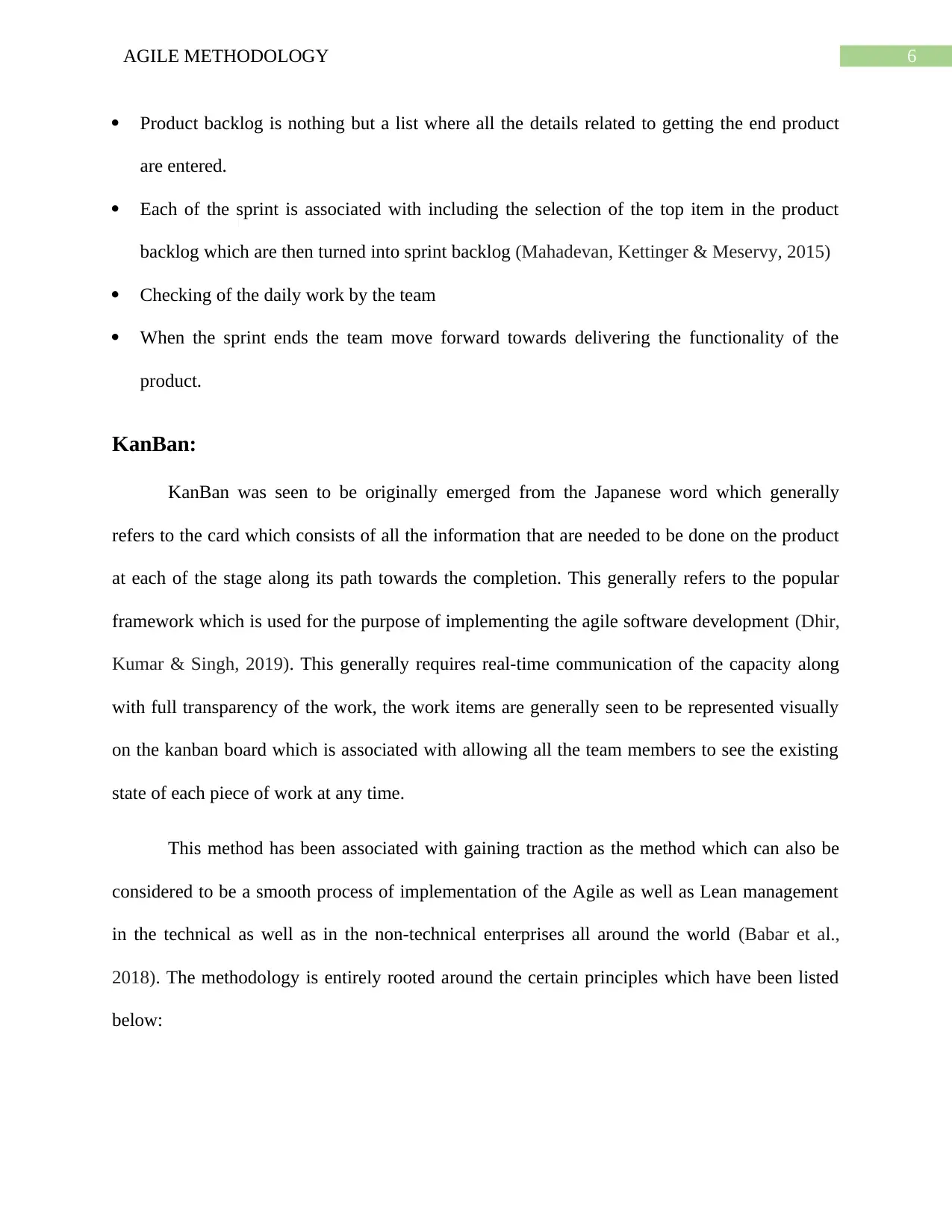
6AGILE METHODOLOGY
Product backlog is nothing but a list where all the details related to getting the end product
are entered.
Each of the sprint is associated with including the selection of the top item in the product
backlog which are then turned into sprint backlog (Mahadevan, Kettinger & Meservy, 2015)
Checking of the daily work by the team
When the sprint ends the team move forward towards delivering the functionality of the
product.
KanBan:
KanBan was seen to be originally emerged from the Japanese word which generally
refers to the card which consists of all the information that are needed to be done on the product
at each of the stage along its path towards the completion. This generally refers to the popular
framework which is used for the purpose of implementing the agile software development (Dhir,
Kumar & Singh, 2019). This generally requires real-time communication of the capacity along
with full transparency of the work, the work items are generally seen to be represented visually
on the kanban board which is associated with allowing all the team members to see the existing
state of each piece of work at any time.
This method has been associated with gaining traction as the method which can also be
considered to be a smooth process of implementation of the Agile as well as Lean management
in the technical as well as in the non-technical enterprises all around the world (Babar et al.,
2018). The methodology is entirely rooted around the certain principles which have been listed
below:
Product backlog is nothing but a list where all the details related to getting the end product
are entered.
Each of the sprint is associated with including the selection of the top item in the product
backlog which are then turned into sprint backlog (Mahadevan, Kettinger & Meservy, 2015)
Checking of the daily work by the team
When the sprint ends the team move forward towards delivering the functionality of the
product.
KanBan:
KanBan was seen to be originally emerged from the Japanese word which generally
refers to the card which consists of all the information that are needed to be done on the product
at each of the stage along its path towards the completion. This generally refers to the popular
framework which is used for the purpose of implementing the agile software development (Dhir,
Kumar & Singh, 2019). This generally requires real-time communication of the capacity along
with full transparency of the work, the work items are generally seen to be represented visually
on the kanban board which is associated with allowing all the team members to see the existing
state of each piece of work at any time.
This method has been associated with gaining traction as the method which can also be
considered to be a smooth process of implementation of the Agile as well as Lean management
in the technical as well as in the non-technical enterprises all around the world (Babar et al.,
2018). The methodology is entirely rooted around the certain principles which have been listed
below:
Paraphrase This Document
Need a fresh take? Get an instant paraphrase of this document with our AI Paraphraser
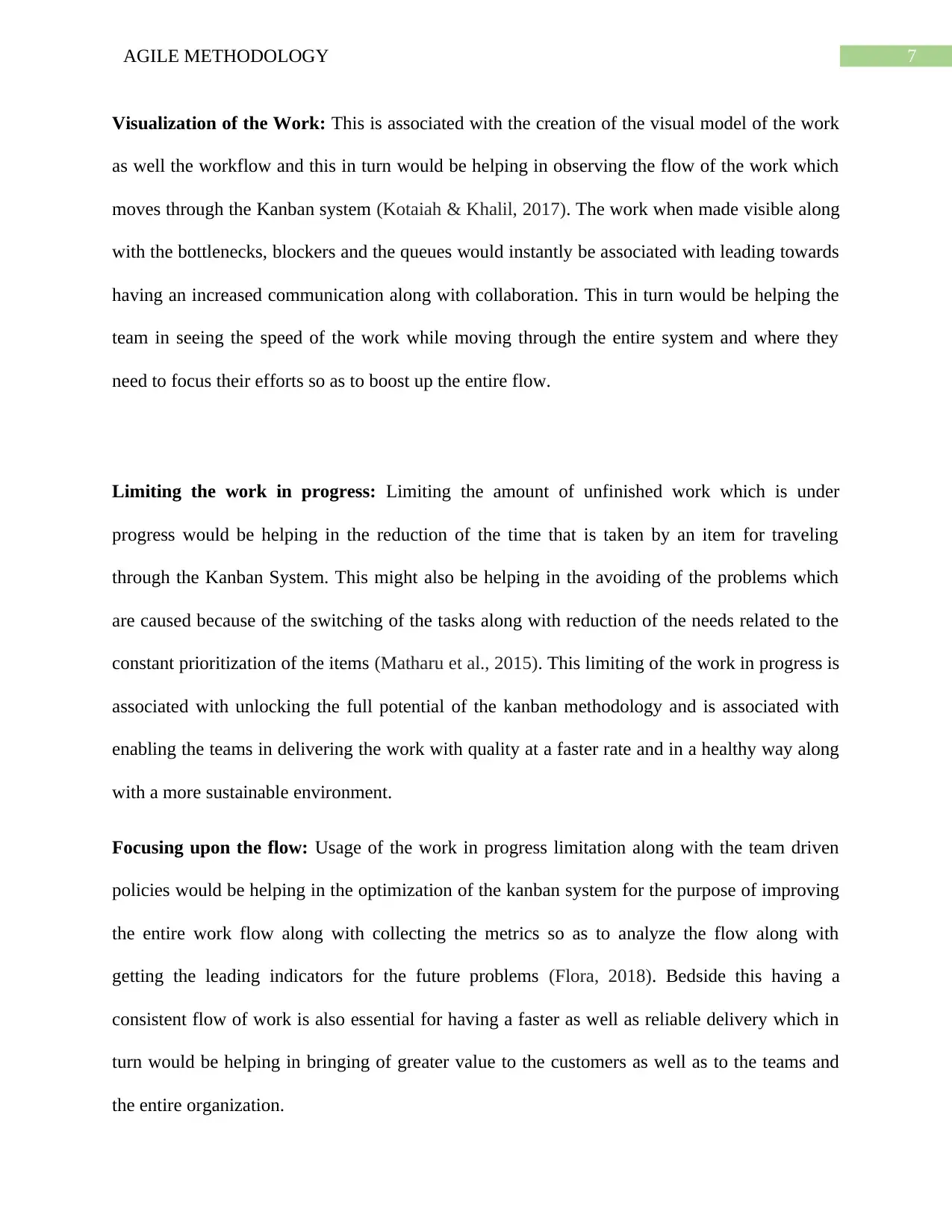
7AGILE METHODOLOGY
Visualization of the Work: This is associated with the creation of the visual model of the work
as well the workflow and this in turn would be helping in observing the flow of the work which
moves through the Kanban system (Kotaiah & Khalil, 2017). The work when made visible along
with the bottlenecks, blockers and the queues would instantly be associated with leading towards
having an increased communication along with collaboration. This in turn would be helping the
team in seeing the speed of the work while moving through the entire system and where they
need to focus their efforts so as to boost up the entire flow.
Limiting the work in progress: Limiting the amount of unfinished work which is under
progress would be helping in the reduction of the time that is taken by an item for traveling
through the Kanban System. This might also be helping in the avoiding of the problems which
are caused because of the switching of the tasks along with reduction of the needs related to the
constant prioritization of the items (Matharu et al., 2015). This limiting of the work in progress is
associated with unlocking the full potential of the kanban methodology and is associated with
enabling the teams in delivering the work with quality at a faster rate and in a healthy way along
with a more sustainable environment.
Focusing upon the flow: Usage of the work in progress limitation along with the team driven
policies would be helping in the optimization of the kanban system for the purpose of improving
the entire work flow along with collecting the metrics so as to analyze the flow along with
getting the leading indicators for the future problems (Flora, 2018). Bedside this having a
consistent flow of work is also essential for having a faster as well as reliable delivery which in
turn would be helping in bringing of greater value to the customers as well as to the teams and
the entire organization.
Visualization of the Work: This is associated with the creation of the visual model of the work
as well the workflow and this in turn would be helping in observing the flow of the work which
moves through the Kanban system (Kotaiah & Khalil, 2017). The work when made visible along
with the bottlenecks, blockers and the queues would instantly be associated with leading towards
having an increased communication along with collaboration. This in turn would be helping the
team in seeing the speed of the work while moving through the entire system and where they
need to focus their efforts so as to boost up the entire flow.
Limiting the work in progress: Limiting the amount of unfinished work which is under
progress would be helping in the reduction of the time that is taken by an item for traveling
through the Kanban System. This might also be helping in the avoiding of the problems which
are caused because of the switching of the tasks along with reduction of the needs related to the
constant prioritization of the items (Matharu et al., 2015). This limiting of the work in progress is
associated with unlocking the full potential of the kanban methodology and is associated with
enabling the teams in delivering the work with quality at a faster rate and in a healthy way along
with a more sustainable environment.
Focusing upon the flow: Usage of the work in progress limitation along with the team driven
policies would be helping in the optimization of the kanban system for the purpose of improving
the entire work flow along with collecting the metrics so as to analyze the flow along with
getting the leading indicators for the future problems (Flora, 2018). Bedside this having a
consistent flow of work is also essential for having a faster as well as reliable delivery which in
turn would be helping in bringing of greater value to the customers as well as to the teams and
the entire organization.
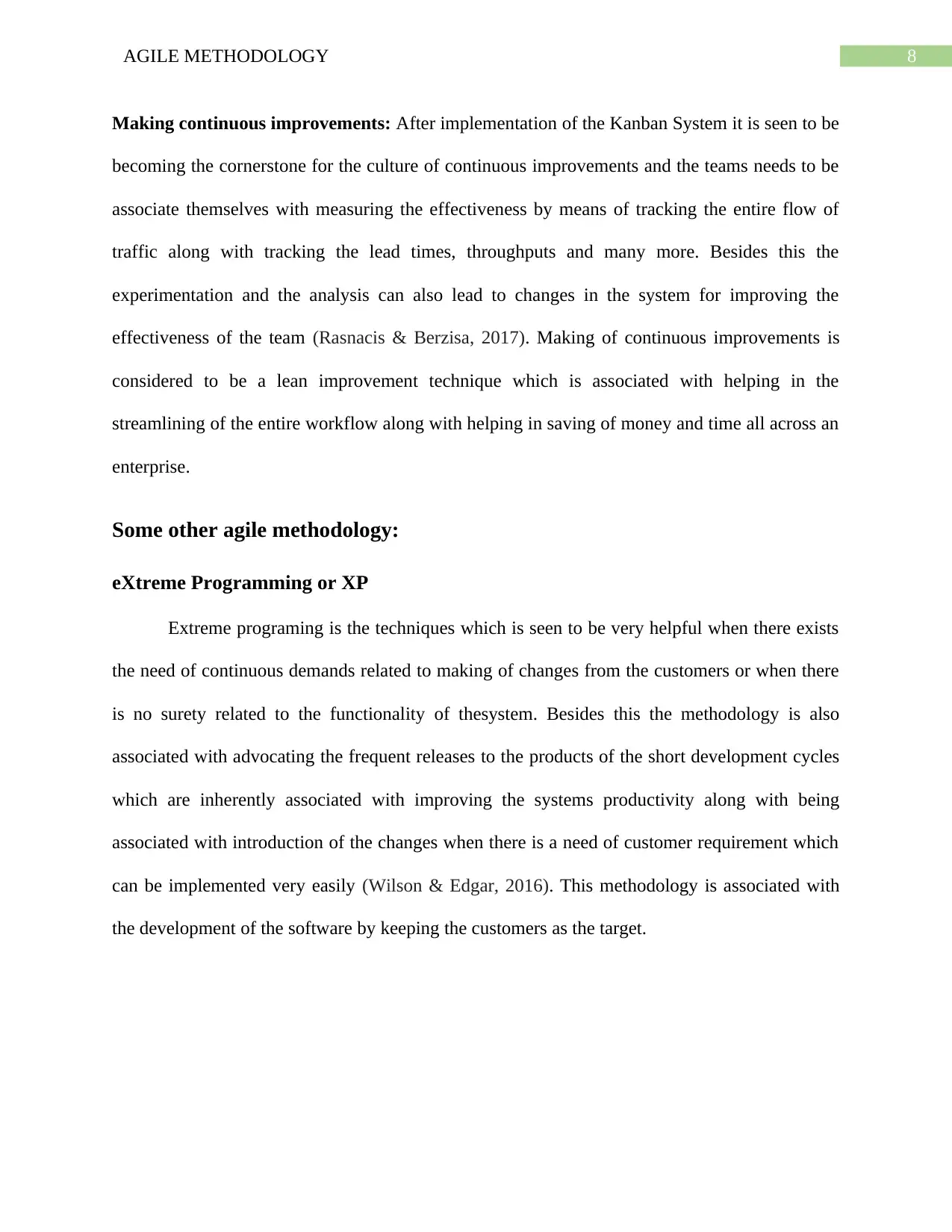
8AGILE METHODOLOGY
Making continuous improvements: After implementation of the Kanban System it is seen to be
becoming the cornerstone for the culture of continuous improvements and the teams needs to be
associate themselves with measuring the effectiveness by means of tracking the entire flow of
traffic along with tracking the lead times, throughputs and many more. Besides this the
experimentation and the analysis can also lead to changes in the system for improving the
effectiveness of the team (Rasnacis & Berzisa, 2017). Making of continuous improvements is
considered to be a lean improvement technique which is associated with helping in the
streamlining of the entire workflow along with helping in saving of money and time all across an
enterprise.
Some other agile methodology:
eXtreme Programming or XP
Extreme programing is the techniques which is seen to be very helpful when there exists
the need of continuous demands related to making of changes from the customers or when there
is no surety related to the functionality of thesystem. Besides this the methodology is also
associated with advocating the frequent releases to the products of the short development cycles
which are inherently associated with improving the systems productivity along with being
associated with introduction of the changes when there is a need of customer requirement which
can be implemented very easily (Wilson & Edgar, 2016). This methodology is associated with
the development of the software by keeping the customers as the target.
Making continuous improvements: After implementation of the Kanban System it is seen to be
becoming the cornerstone for the culture of continuous improvements and the teams needs to be
associate themselves with measuring the effectiveness by means of tracking the entire flow of
traffic along with tracking the lead times, throughputs and many more. Besides this the
experimentation and the analysis can also lead to changes in the system for improving the
effectiveness of the team (Rasnacis & Berzisa, 2017). Making of continuous improvements is
considered to be a lean improvement technique which is associated with helping in the
streamlining of the entire workflow along with helping in saving of money and time all across an
enterprise.
Some other agile methodology:
eXtreme Programming or XP
Extreme programing is the techniques which is seen to be very helpful when there exists
the need of continuous demands related to making of changes from the customers or when there
is no surety related to the functionality of thesystem. Besides this the methodology is also
associated with advocating the frequent releases to the products of the short development cycles
which are inherently associated with improving the systems productivity along with being
associated with introduction of the changes when there is a need of customer requirement which
can be implemented very easily (Wilson & Edgar, 2016). This methodology is associated with
the development of the software by keeping the customers as the target.
⊘ This is a preview!⊘
Do you want full access?
Subscribe today to unlock all pages.

Trusted by 1+ million students worldwide
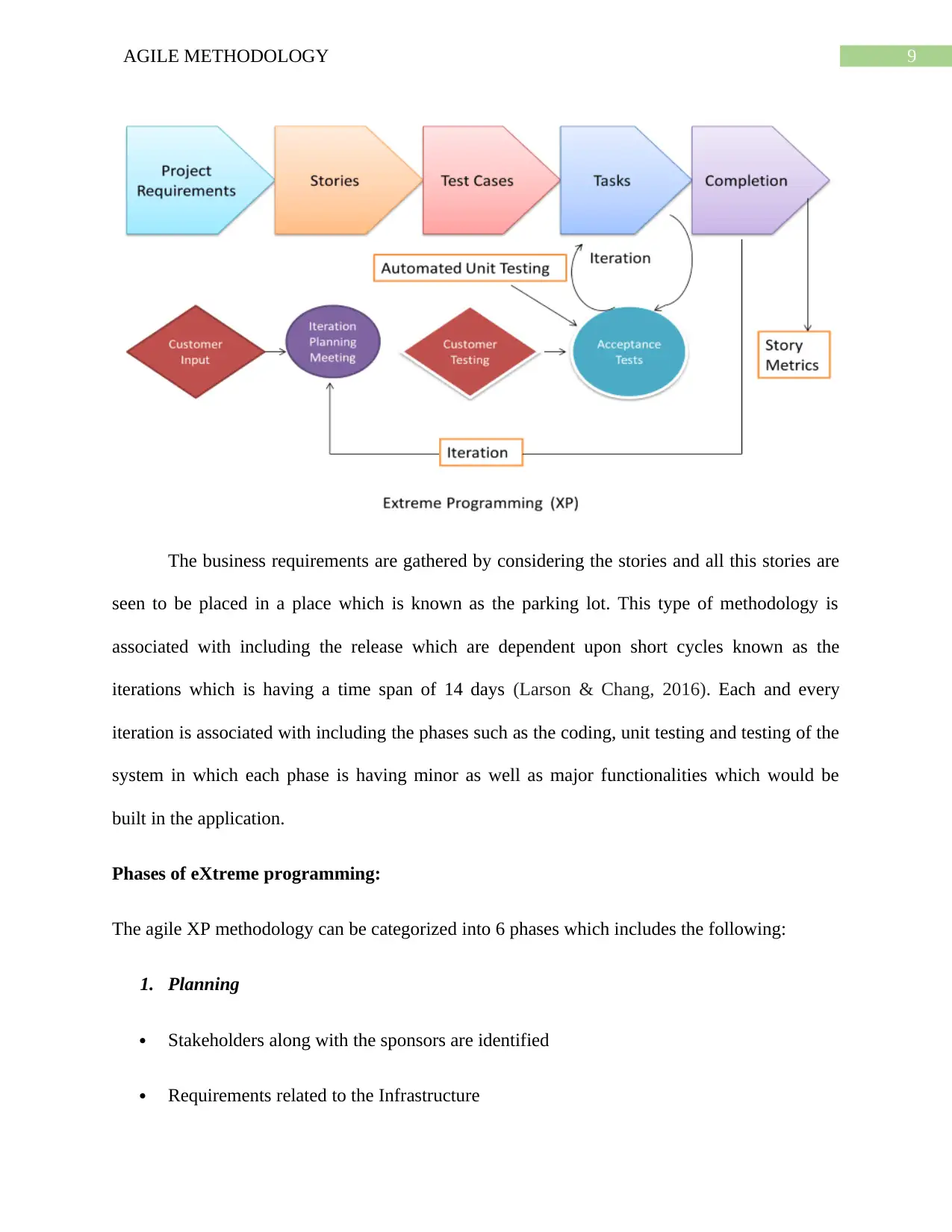
9AGILE METHODOLOGY
The business requirements are gathered by considering the stories and all this stories are
seen to be placed in a place which is known as the parking lot. This type of methodology is
associated with including the release which are dependent upon short cycles known as the
iterations which is having a time span of 14 days (Larson & Chang, 2016). Each and every
iteration is associated with including the phases such as the coding, unit testing and testing of the
system in which each phase is having minor as well as major functionalities which would be
built in the application.
Phases of eXtreme programming:
The agile XP methodology can be categorized into 6 phases which includes the following:
1. Planning
Stakeholders along with the sponsors are identified
Requirements related to the Infrastructure
The business requirements are gathered by considering the stories and all this stories are
seen to be placed in a place which is known as the parking lot. This type of methodology is
associated with including the release which are dependent upon short cycles known as the
iterations which is having a time span of 14 days (Larson & Chang, 2016). Each and every
iteration is associated with including the phases such as the coding, unit testing and testing of the
system in which each phase is having minor as well as major functionalities which would be
built in the application.
Phases of eXtreme programming:
The agile XP methodology can be categorized into 6 phases which includes the following:
1. Planning
Stakeholders along with the sponsors are identified
Requirements related to the Infrastructure
Paraphrase This Document
Need a fresh take? Get an instant paraphrase of this document with our AI Paraphraser
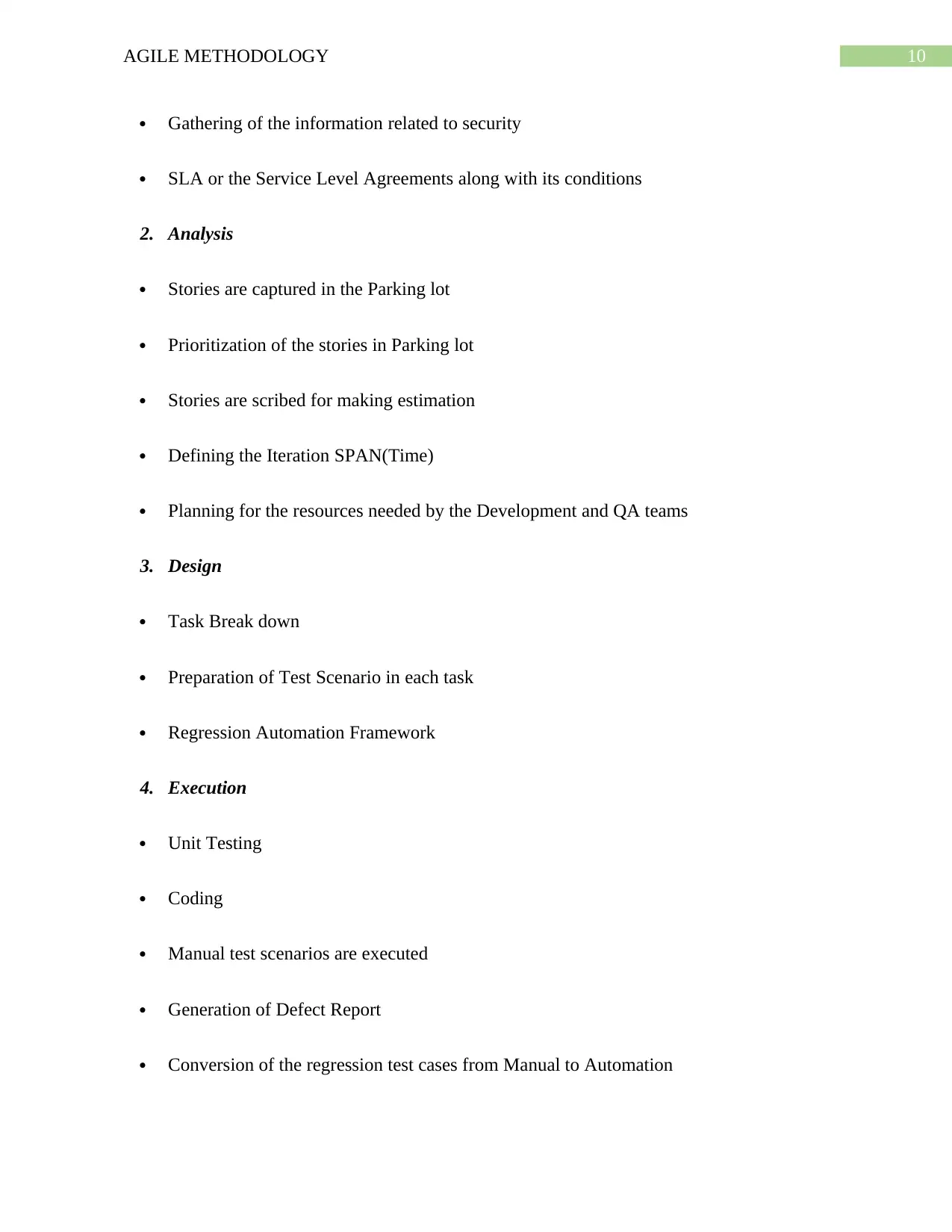
10AGILE METHODOLOGY
Gathering of the information related to security
SLA or the Service Level Agreements along with its conditions
2. Analysis
Stories are captured in the Parking lot
Prioritization of the stories in Parking lot
Stories are scribed for making estimation
Defining the Iteration SPAN(Time)
Planning for the resources needed by the Development and QA teams
3. Design
Task Break down
Preparation of Test Scenario in each task
Regression Automation Framework
4. Execution
Unit Testing
Coding
Manual test scenarios are executed
Generation of Defect Report
Conversion of the regression test cases from Manual to Automation
Gathering of the information related to security
SLA or the Service Level Agreements along with its conditions
2. Analysis
Stories are captured in the Parking lot
Prioritization of the stories in Parking lot
Stories are scribed for making estimation
Defining the Iteration SPAN(Time)
Planning for the resources needed by the Development and QA teams
3. Design
Task Break down
Preparation of Test Scenario in each task
Regression Automation Framework
4. Execution
Unit Testing
Coding
Manual test scenarios are executed
Generation of Defect Report
Conversion of the regression test cases from Manual to Automation
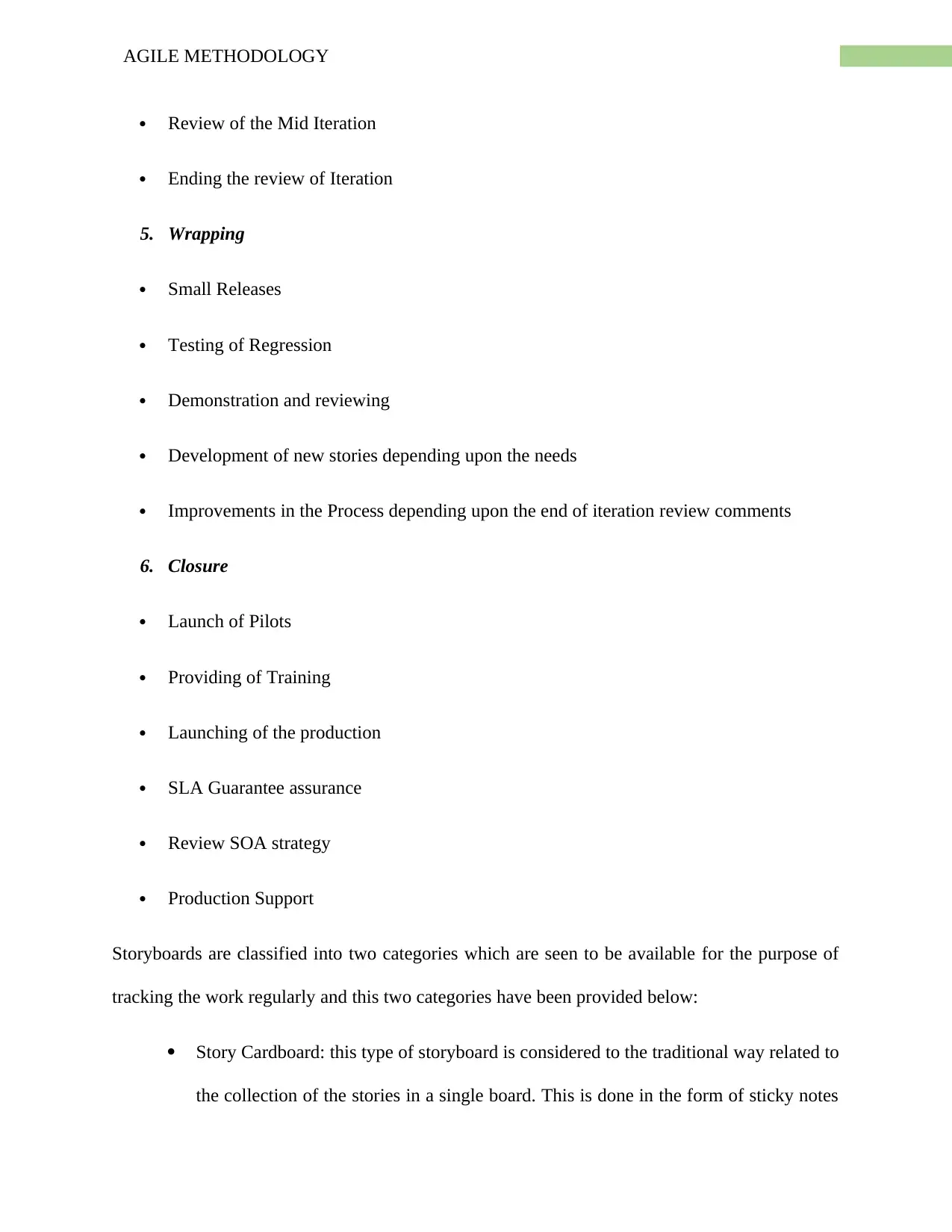
11AGILE METHODOLOGY
Review of the Mid Iteration
Ending the review of Iteration
5. Wrapping
Small Releases
Testing of Regression
Demonstration and reviewing
Development of new stories depending upon the needs
Improvements in the Process depending upon the end of iteration review comments
6. Closure
Launch of Pilots
Providing of Training
Launching of the production
SLA Guarantee assurance
Review SOA strategy
Production Support
Storyboards are classified into two categories which are seen to be available for the purpose of
tracking the work regularly and this two categories have been provided below:
Story Cardboard: this type of storyboard is considered to the traditional way related to
the collection of the stories in a single board. This is done in the form of sticky notes
Review of the Mid Iteration
Ending the review of Iteration
5. Wrapping
Small Releases
Testing of Regression
Demonstration and reviewing
Development of new stories depending upon the needs
Improvements in the Process depending upon the end of iteration review comments
6. Closure
Launch of Pilots
Providing of Training
Launching of the production
SLA Guarantee assurance
Review SOA strategy
Production Support
Storyboards are classified into two categories which are seen to be available for the purpose of
tracking the work regularly and this two categories have been provided below:
Story Cardboard: this type of storyboard is considered to the traditional way related to
the collection of the stories in a single board. This is done in the form of sticky notes
⊘ This is a preview!⊘
Do you want full access?
Subscribe today to unlock all pages.

Trusted by 1+ million students worldwide
1 out of 24
Related Documents
Your All-in-One AI-Powered Toolkit for Academic Success.
+13062052269
info@desklib.com
Available 24*7 on WhatsApp / Email
![[object Object]](/_next/static/media/star-bottom.7253800d.svg)
Unlock your academic potential
Copyright © 2020–2025 A2Z Services. All Rights Reserved. Developed and managed by ZUCOL.





